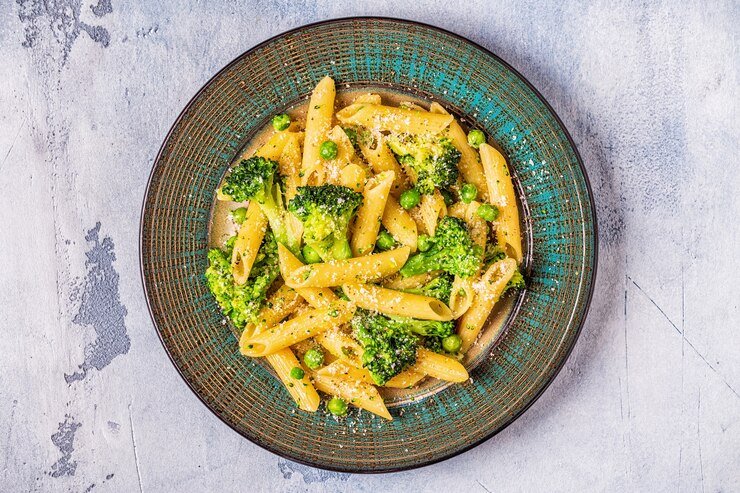What is broccoli pasta made of? Broccoli pasta, a dish as simple as it sounds, combines the hearty textures of pasta with the fresh, green zest of broccoli. This dish is a favorite among those looking to whip up a quick meal without skimping on health benefits. It’s versatile enough to be tailored to anyone’s taste, making it a staple in kitchens worldwide.
Popularity and Culinary Use
The popularity of broccoli pasta can be credited to its simplicity and the wave of interest in health-conscious meals. As folks lean towards incorporating more vegetables in their diets, broccoli pasta serves as a perfect vehicle. It’s not just about throwing pasta and broccoli together; it’s about creating a harmonious dish that’s both satisfying and nutritious.
This introduction sets the stage for a deeper exploration into what makes broccoli pasta a standout dish in modern kitchens. As we progress through the article, we’ll unpack the various elements that contribute to its charm and versatility. Stay tuned as we delve into the ingredients that make up this delightful dish, highlighting how each component brings something special to the table.
Ingredients and Variations
Essential Ingredients for Broccoli Pasta
- Fresh Broccoli: Choose vibrant, fresh broccoli for crunch and health benefits.
- Pasta Choices: Fusilli holds sauce well; penne offers delightful texture.
- Sauce Selection: Personalize with garlic and olive oil, creamy Alfredo, or zesty tomato.
- Seasoning Options: Add Italian herbs, red pepper flakes, or Parmesan.
- Combining Ingredients: Mix pasta, broccoli, sauce, and seasonings thoroughly.
- Final Touches: Garnish with fresh basil or parsley before serving.
Common Variations and Additions
The basic broccoli pasta is a classic, yet there are endless ways to enhance its appeal. By adding cheese—perhaps a sprinkle of Parmesan or a dollop of creamy goat cheese—you can introduce a rich depth of flavor. Additionally, for those looking to boost their protein intake, incorporating chicken strips or paneer can transform it into a more substantial meal. Moreover, don’t shy away from including other vegetables like sun-dried tomatoes or bell peppers to introduce more colors and flavors to your dish.
Through these variations, broccoli pasta not only adapts to different palates but also to various occasions. It can serve as a quick weeknight dinner or be transformed into a more elaborate dish for guests. The key lies in the ingredients and how you choose to bring them together, making broccoli pasta a canvas for culinary creativity.
In the next section, we will explore the nutritional benefits of broccoli pasta, emphasizing how this dish isn’t just delicious but also a wise choice for a healthy lifestyle. Furthermore, stay tuned to uncover the nutritional powerhouse behind the ingredients of this beloved dish

Nutritional Benefits
Health Benefits of Broccoli
Broccoli is not only a key player in broccoli pasta but also a nutritional superstar in its own right. Rich in vitamins K and C, it offers more than just a pleasant crunch; it supports bone health and acts as a powerful antioxidant. Moreover, the fiber content in broccoli aids in digestion and helps maintain a healthy gut, making it a fantastic choice for those looking to boost their overall health.
Nutritional Content of Pasta
Pasta, often unfairly maligned in discussions of diet and health, actually provides a good source of energy. Opting for whole grain or fortified pastas can enhance your meal’s nutritional profile, offering additional fiber and nutrients such as B vitamins. It’s all about choosing the right type of pasta and portion sizes to align with a balanced diet.
Balancing a Healthy Plate
Combining broccoli with pasta makes a balanced, satisfying dish. Choose the right sauce and add lean proteins or other veggies for a well-rounded meal. Tips on meal balance can enhance your dietary choices.
This dish isn’t just tasty—it’s also healthy. Understanding each ingredient lets you enjoy this meal, knowing it’s good for your body and soul.
Next, we’ll explore cooking techniques to enhance your broccoli pasta’s flavor and texture. Stay tuned for tips that will improve your cooking skills!
Cooking Techniques
Preparing Broccoli for Pasta
To maximize the flavor and texture of broccoli in your pasta dish, start by choosing fresh, firm broccoli heads. Cutting the broccoli into uniform pieces ensures even cooking. Blanche the broccoli briefly in boiling water before sautéing to preserve its vibrant green color and to soften it just right. This pre-cooking step helps in integrating the broccoli seamlessly into the pasta, enhancing both the look and taste of the dish.
Best Practices for Cooking Pasta
Cooking pasta might seem straightforward, but a few tricks can elevate your pasta from good to great. Always use a large pot with plenty of boiling, salted water to give the pasta room to cook evenly and absorb flavors. Stirring occasionally prevents sticking and tests for the perfect ‘al dente’ texture are crucial. Draining the pasta well and tossing it with a bit of olive oil can prevent it from becoming gummy.
Combining Ingredients
The final step in making broccoli pasta is combining the ingredients. After draining the pasta, toss it immediately with the broccoli and your chosen sauce to allow the flavors to meld beautifully. A quick toss over heat can help thicken the sauce and coat the pasta and broccoli evenly, resulting in a dish that’s uniformly delicious.
These techniques not only ensure that each component of broccoli pasta shines but also contribute to a dish that’s appealing and satisfying. Employing these tips will help you achieve a restaurant-quality meal at home.
Serving Suggestions
Dish Presentation
Presentation plays a key role in elevating the dining experience, and broccoli pasta is no exception. Serve it in a warm bowl or a broad plate to showcase its vibrant colors and textures. Garnishing with fresh herbs like basil or parsley not only adds a pop of color but also a burst of freshness right before serving. A light sprinkle of grated Parmesan or a drizzle of extra virgin olive oil can also enhance the visual appeal and flavor.
Accompaniments
While broccoli pasta is delightful on its own, pairing it with the right side dishes can turn a simple meal into a feast. Consider serving it with a side of crusty garlic bread to complement the textures and flavors. A fresh salad with a light vinaigrette dressing can balance the richness of the pasta, adding a crisp, refreshing element to your meal.
These serving suggestions are designed to ensure that every aspect of your broccoli pasta dish is enjoyed to its fullest. From the way it’s presented to the sides chosen to accompany it, each element is thought out to enhance the overall dining experience.
Next, we will answer some frequently asked questions about broccoli pasta. This section aims to provide useful tips and solutions to common queries, helping you perfect your broccoli pasta dishes every time. Stay tuned for practical advice that will take your cooking to the next level.
Storing and Reheating Tips
Proper Storage Techniques
To ensure your broccoli pasta remains fresh and tasty, proper storage is key. After cooking, allow the pasta to cool to room temperature before transferring it to an airtight container. It’s best to store the pasta and sauce separately if possible, as this helps maintain the pasta’s texture and prevents it from becoming soggy. Refrigerate immediately, and consume within 3-4 days for the best quality.
Reheating for Best Results
- Gentle Reheating: Preserve texture and flavor with gentle reheating.
- Microwave Tips: Add water or sauce, cover, and microwave to steam broccoli.
- Stovetop Alternative: For enhanced flavor, reheat in a skillet with extra sauce or olive oil over medium heat.
- Key to Freshness: These tips ensure your broccoli pasta stays delicious for days, preventing waste.
Alternative Dietary Adaptations
Making Broccoli Pasta Vegan
Transforming broccoli pasta into a vegan delight is straightforward. Replace any dairy-based sauce components with plant-based alternatives such as cashew cream or vegan cheese. Opt for whole-grain pasta to keep it hearty and nutritious, and consider adding nutritional yeast for a cheesy flavor without the dairy.
Low-Carb Options
For those following a low-carb diet, broccoli pasta can still be on the menu. Swap traditional pasta for spiralized vegetables or shirataki noodles. These substitutes offer a pasta-like texture with a fraction of the carbs, making it a suitable option for carb-conscious diners.
High-Protein Variations
Boosting the protein content in broccoli pasta can make it more satiating. Incorporate plant-based proteins like chickpeas or tofu, or lean animal proteins like chicken or turkey. These additions make the dish more filling and nutritionally balanced.
This section offers guidance on how to adapt broccoli pasta to various dietary needs, ensuring everyone can enjoy this versatile dish tailored to their health preferences and restrictions.



1 réflexion au sujet de « What is broccoli pasta made of? »